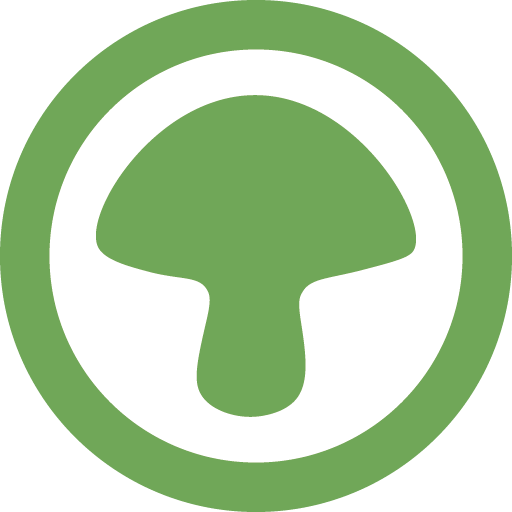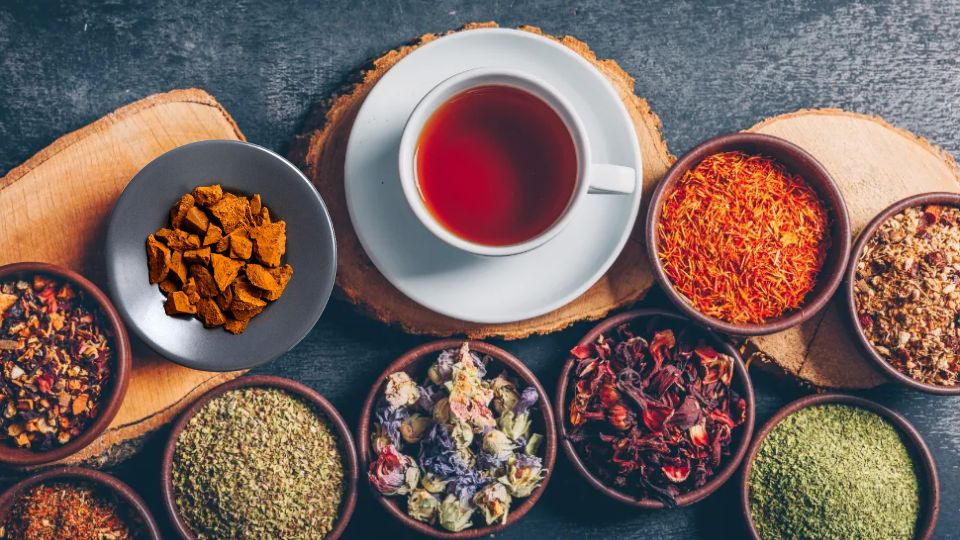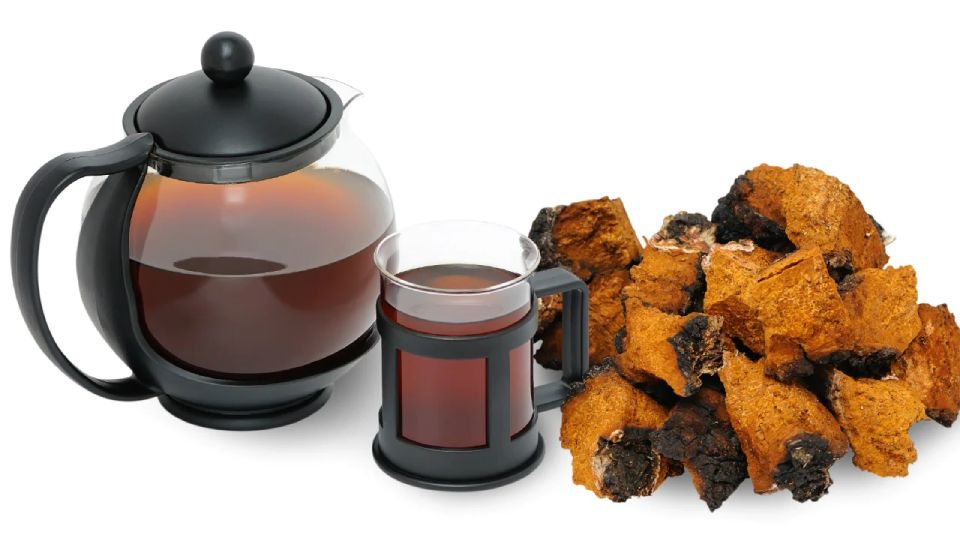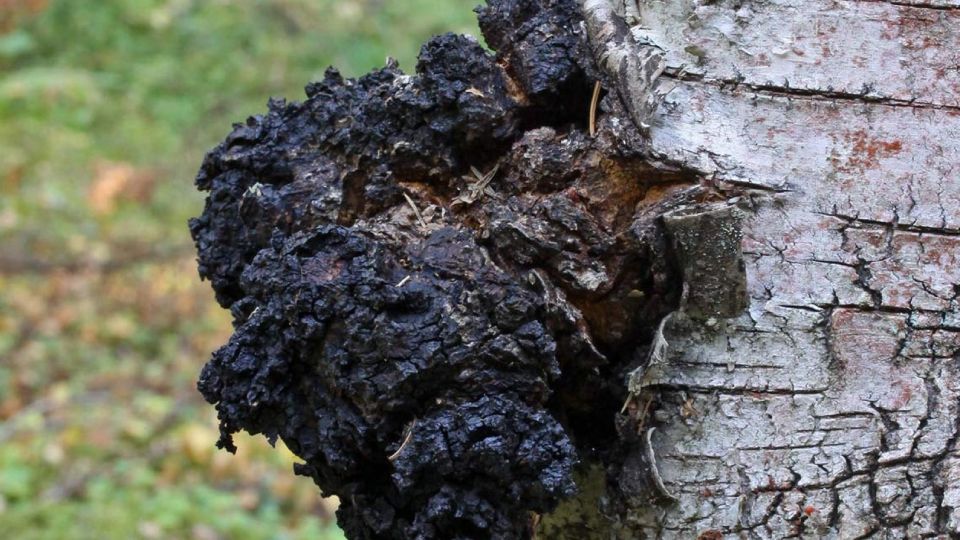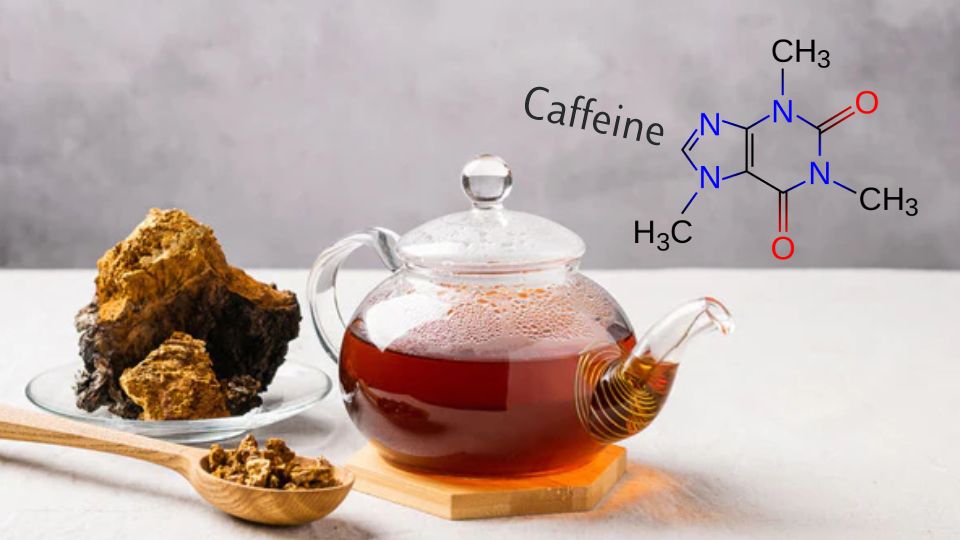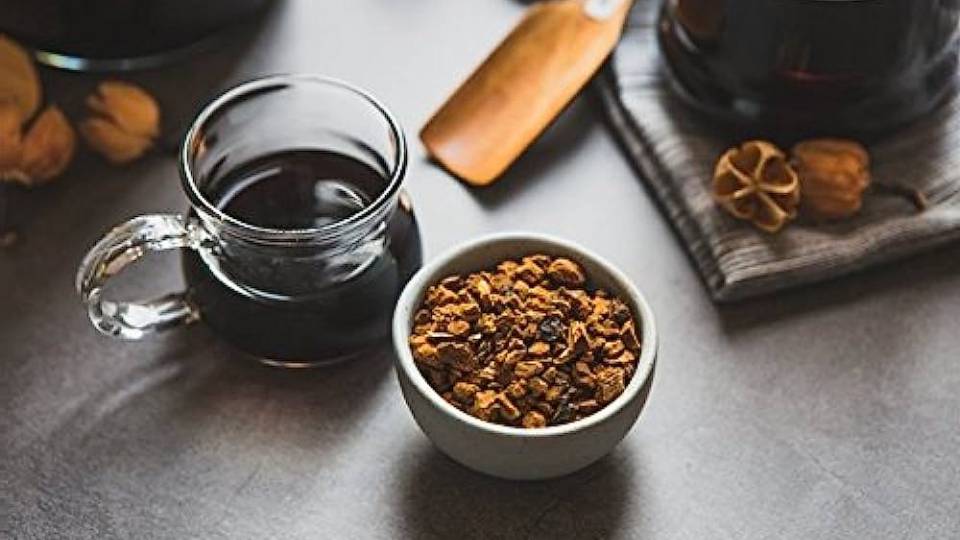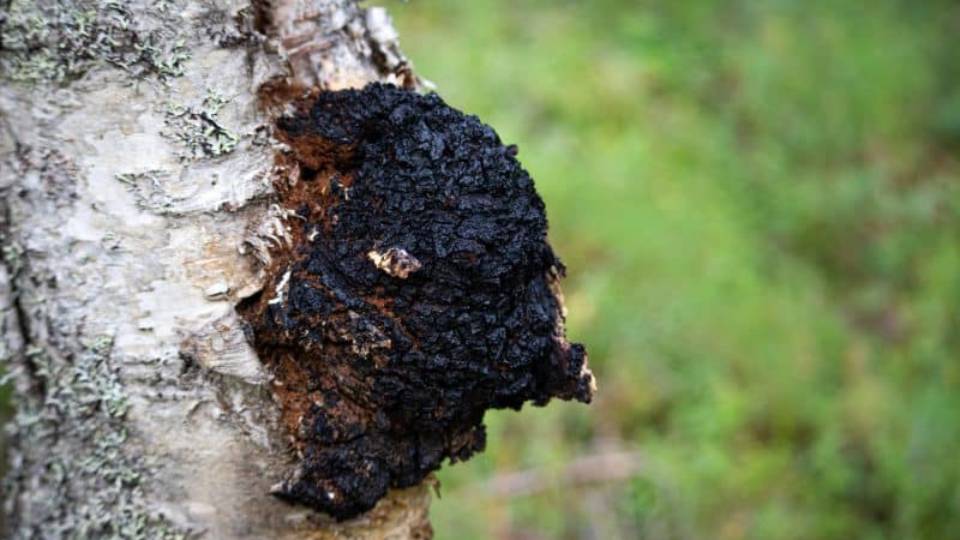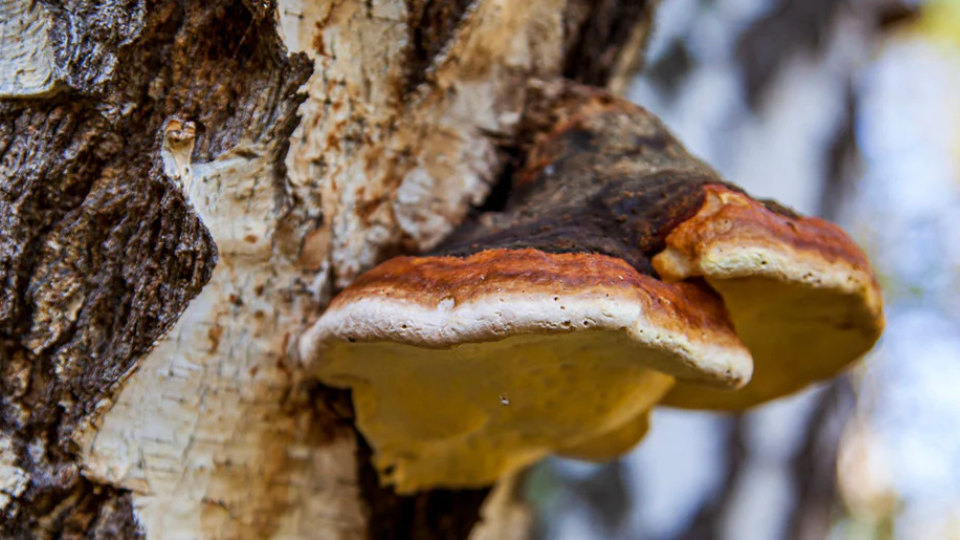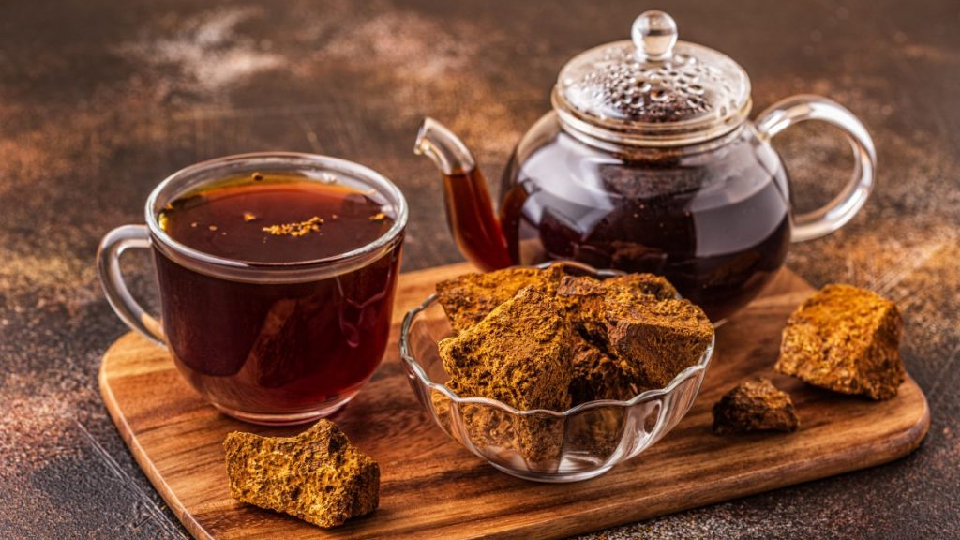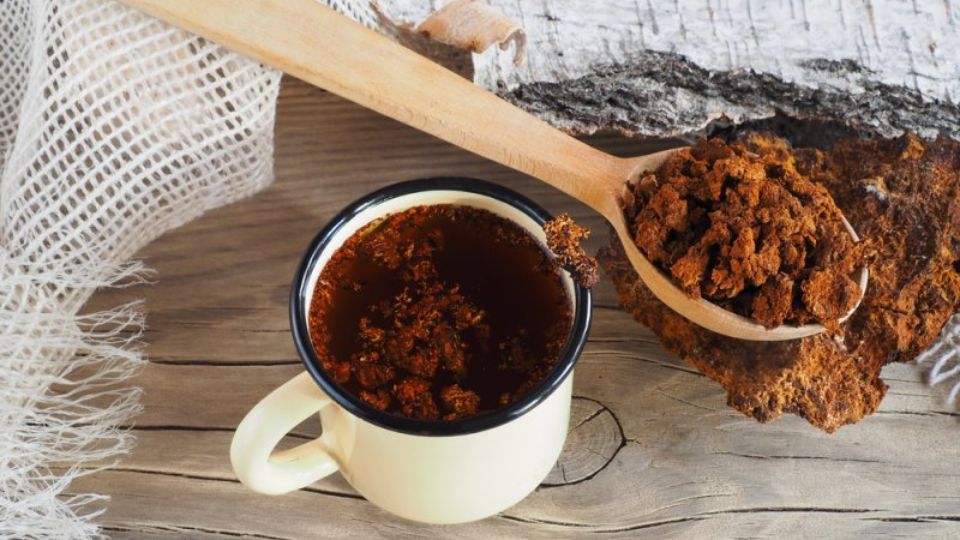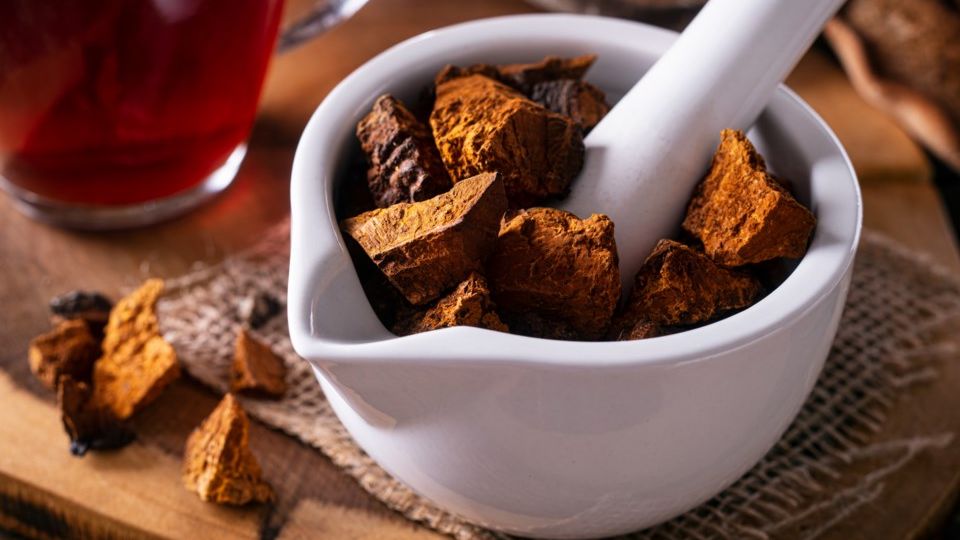
Chaga Mushroom: A Complete Guide
As mycologists and lovers of all things related to fungi, we are thrilled to delve into the captivating world of Chaga Mushroom – a unique, nutrient-rich, and fascinating fungus found on birch trees in northern climates.
This mushroom is a unique, nutrient-rich, and fascinating fungus found on birch trees in northern climates. It offers impressive health benefits. One of the reasons it’s so good for you is its high ORAC score, which stands for “oxygen radical absorbent capacity.”
The higher the ORAC value, the better the food can protect your body from disease-causing free radicals[1]. Chaga mushrooms are among the best sources of antioxidants.
So, why do people want to add chaga mushrooms to their diets? Well, it’s because of the numerous potential benefits it offers. People have turned to these mushrooms for various health concerns, including heart disease, diabetes, liver disease, parasites, stomach pain, and certain types of cancer.
Let’s delve into the exciting potential benefits of Chaga and understand why disease-fighting mushrooms are creating such a buzz these days.
What is The Chaga Mushroom?
The Chaga mushroom (Inonotus obliquus) draws nutrients from the host birch tree, sustaining itself through a slow-growing fungus. It boasts several other names, including black mass, clinker polypore, birch canker polypore, cinder conk, and the sterile conk trunk rot of birch. Unlike traditional mushrooms, they have a bitter yet vanilla taste, alongside being high in fiber and low in calories.
This unique growth process enables the accumulation of an array of beneficial compounds, turning it into a powerhouse of nutrients and bioactive substances. Chaga has been utilized to treat diabetes, certain cancers, and heart disease.
Traditionally, people grated chaga into a fine powder and brewed it as herbal tea[2]. Nowadays, you can find chaga not only as tea but also in the form of powdered, or capsuled supplements, or even gummies.
Chaga Identification
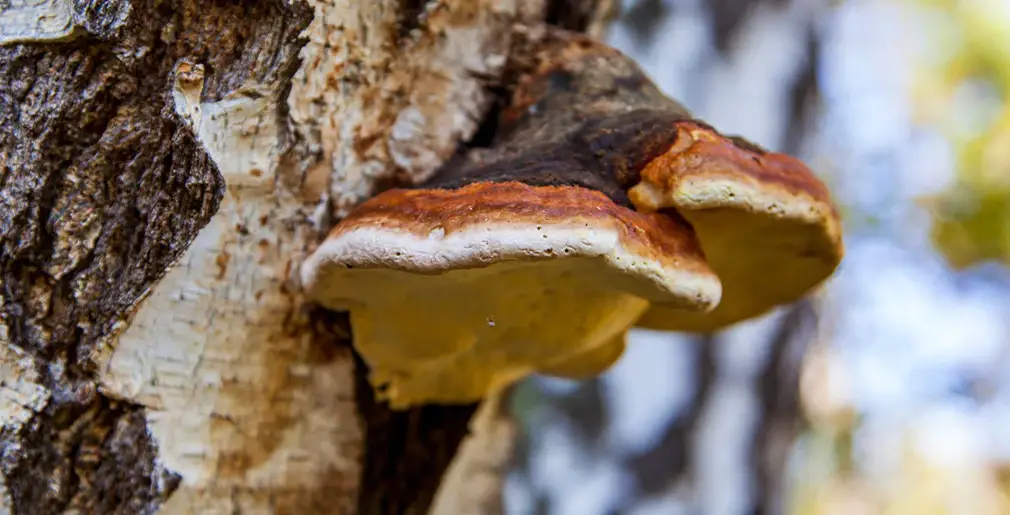
These mushrooms are easy to identify due to their distinct appearance. So, what do chaga mushrooms look like? They have a lumpy texture with an exterior resembling burnt charcoal, while their core is softer and squishy with a yellow-orange hue.
This fascinating mushroom forms a woody growth called a conk, resembling a clump of burnt charcoal, and measures around 10 to 15 inches (25 to 38 centimeters) in size. However, once you crack it open, you’ll discover a soft, orange-colored core.
When they grow on birch trees, they make quite a sight. Resembling burnt wood, they often cluster together, sometimes growing as large as a human head.
To get the benefits of Chaga, like other medicinal fungi, hot water or alcohol is used to break down their tough cellular walls. This process allows the beneficial properties of the mushroom to be readily available for human use.
History
For centuries, Chaga mushrooms have been a vital part of traditional medicine. Historical records suggest their use dates back to ancient cultures in Europe and Asia, where they were believed to have healing properties for various ailments. In modern times, studies have found that they contain a variety of beneficial compounds such as polysaccharides, antioxidants, and triterpenes that may have anti-inflammatory, anti-cancer, and anti-microbial properties[3].
Cultivation of these mushrooms has since become widespread in countries like China, Russia, and Korea, and their medicinal benefits continue to be explored.
What Does Chaga Do For The Body?
This mushroom contributes various benefits to the body. Researchers have extensively studied its potential, especially in combating cancer[4]. Additionally, it contains antioxidants and nutrients that support overall health[5].
Can Chaga Be Put in Coffee? Absolutely!
Currently, mushroom coffee and tea are gaining popularity. Interestingly, during World War I and World War II, people indeed used Chaga mushrooms as a coffee substitute due to the scarcity of coffee. The practical choice arose from its availability in the wild and its coffee-like flavor, making it a viable alternative during those times of limited resources.
NOTE
Although further research is necessary, Chaga mushrooms have already shown potential for various health purposes.
Health Benefits
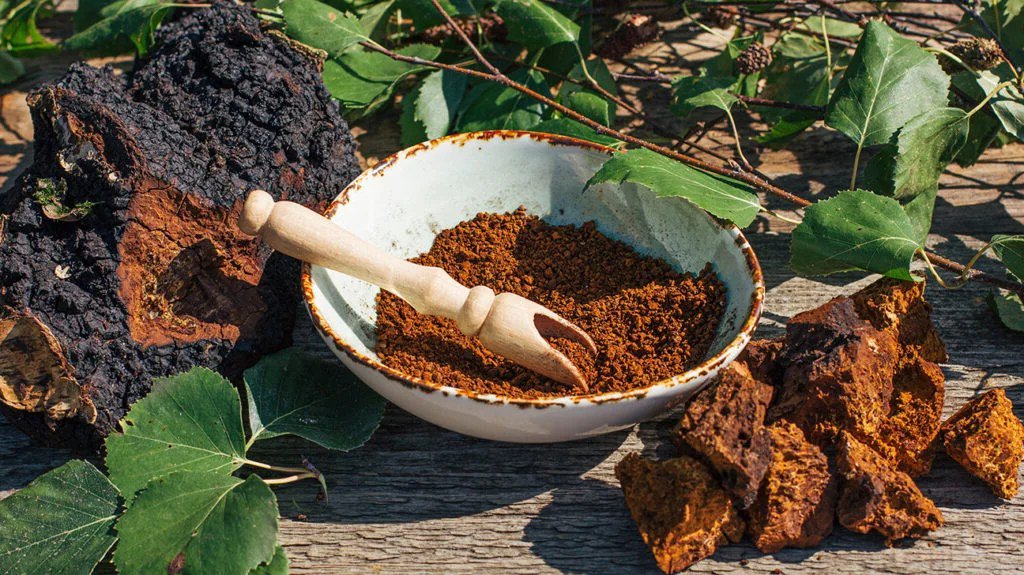
1. Cancer-Fighting Properties
One of the most intriguing health benefits of Chaga lies in its potential to combat cancer. Studies suggest that it contains compounds like betulinic acid and polysaccharides, which may inhibit tumor growth and stimulate the immune system to fight cancer cells effectively.
They have shown promising results in both animal and test-tube studies, indicating their potential to prevent and slow down cancer growth. For instance, in a study involving mice with cancer, Chaga supplements led to a significant 60% reduction in tumor size.
Moreover, test-tube studies have demonstrated that this mushroom extract can inhibit cancer growth in various human cells, including those in the liver, lung, breast, prostate, and colon. This anticancer effect is attributed, at least in part, to the high antioxidant content found in them, which helps shield cells from damage caused by free radicals[6].
It’s important to note that while these findings are promising, further research with human studies is necessary to establish stronger conclusions about Chaga’s potential as an anticancer agent.
2. Boosting the Immune System
They are rich in beta-glucans, which are known to enhance the immune system’s functionality. And they have the potential to support the immune system by aiding in the regulation of cytokine production, facilitating better communication among cells. This support could be beneficial in combating infections, ranging from minor colds to severe and life-threatening illnesses.
During an illness, the body relies on inflammation to fight off the invaders. However, there are instances where inflammation shifts from a short-term defense to a chronic health issue.
Inflammatory-linked illnesses, especially chronic conditions like rheumatoid arthritis, are associated with this persistent inflammation. Interestingly, recent research suggests that even conditions not typically considered inflammatory, such as depression, may be partially influenced by chronic inflammation[7].
Regular consumption of Chaga tea or extracts may help fortify your body’s natural defense against infections and illnesses.
3. Lowers Blood Sugar
These mushrooms boast an impressive ORAC (Oxygen Radical Absorbance Capacity) value, indicating their ability to neutralize harmful free radicals in the body. For those who are dealing with insulin resistance, polycystic ovarian syndrome, or Type 2 diabetes, incorporating chaga mushrooms into their routine may offer potential benefits by reducing blood sugar levels and improving insulin resistance.
Various studies have shown promising results, with potential blood sugar level reductions of up to 31%. Notably, a recent study conducted on obese, diabetic mice demonstrated that chaga extract effectively lowered blood sugar levels and improved insulin resistance compared to mice without the supplement[8].
However, it’s essential to highlight that more research, especially on human subjects, is still needed to conclusively determine Chaga’s effectiveness in managing diabetes in humans. Nonetheless, the existing findings indicate the exciting potential of these mushrooms as a natural approach to support blood sugar regulation and insulin resistance.
4. Lowering cholesterol
The high fiber content in Chaga mushrooms may aid in promoting a healthy digestive system by supporting regular bowel movements and optimizing nutrient absorption.
Also, they are rich in antioxidants and have the potential to contribute to lowering cholesterol levels, thereby reducing the risk of heart disease.
A study revealed that Chaga mushrooms effectively reduced “bad” LDL cholesterol, triglycerides, and overall cholesterol levels while also boosting antioxidant levels. Furthermore, there is evidence suggesting that these mushrooms may have a positive impact on increasing “good” HDL cholesterol[9].
5. Anti-Inflammatory Properties
The mushroom contains triterpenoids, a type of compound known for its anti-inflammatory effects. For instance, in an animal study, this mushroom extract was found to effectively reduce inflammation caused by ulcerative colitis. The researchers discovered that the extract suppressed the expression of chemical mediators responsible for inflammation in the colon.
This finding is highly significant because these chemical mediators intensify inflammation and perpetuate the inflammatory response. By inhibiting their expression, the extract can effectively alleviate inflammation, offering potential therapeutic benefits[10].
6. Potent Antiviral
This mushroom exhibits antiviral abilities against several viruses. A scientific study from 2015 revealed that chaga extracts have an antiviral effect on human immunodeficiency virus (HIV) type 1.
Moreover, animal studies have demonstrated its potential against the hepatitis C virus. In just 10 minutes, the extract reduced the infective properties of the hepatitis C virus by 100-fold using animal cells[11].
Ongoing research continues to explore its antiviral properties, suggesting that this mushroom holds great promise for the development of new antiviral drugs.
Nutrition and Compound Facts
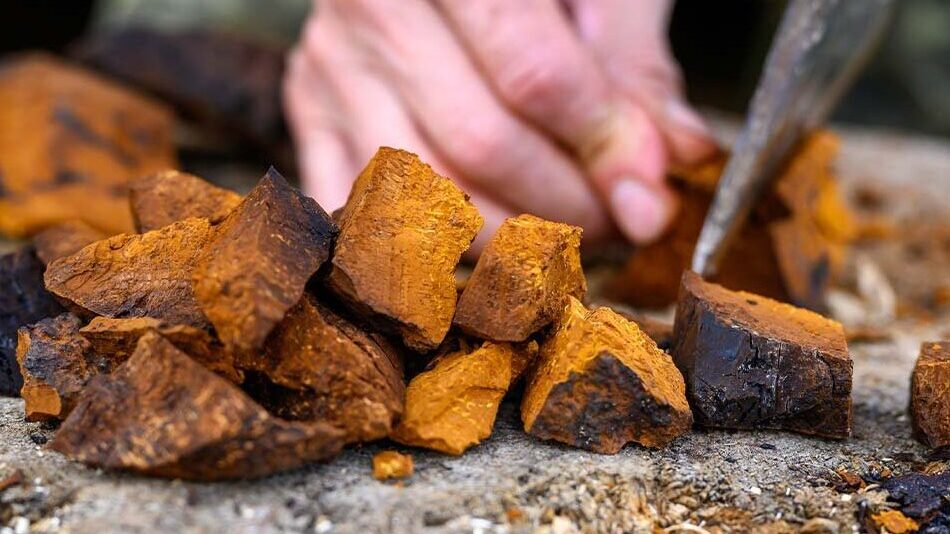
These mushrooms boast a remarkable antioxidant and Beta-glucans content, with low calories and fat, while providing an abundance of fiber and being entirely sugar-free. It is rich in melanin, which is not only responsible for its dark color but also beneficial for promoting healthy skin. Topical application of Chaga extract may help soothe skin irritations and maintain a youthful complexion.
Approximately 100g of raw chaga chunks contain these beneficial attributes:
| Nutrient | Amount per 100g |
| Calories | 215 kcal |
| Carbohydrates | 35.65 g |
| Fiber | 31.9 g |
| Protein | 3.77 g |
| Fat | 0.44 g |
| Vitamin B1 (Thiamin) | 0.02 mg |
| Vitamin B2 (Riboflavin) | 0.1 mg |
| Vitamin B3 (Niacin) | 3.65 mg |
| Vitamin B5 (Pantothenic Acid) | 0.32 mg |
| Vitamin B6 | 0.5 mg |
| Vitamin K | 5.3 mcg |
| Calcium | 276 mg |
| Iron | 7.6 mg |
| Magnesium | 325 mg |
| Phosphorus | 1130 mg |
| Potassium | 3680 mg |
| Zinc | 3.2 mg |
| Copper | 0.45 mg |
| Manganese | 60.5 mg |
| Selenium | 53.4 mcg |
| Beta-glucans | 5.4 g |
| Antioxidants | High |
How to Use Chaga
Using mushrooms in your daily life can be a delightful and beneficial experience. So, how can you incorporate chaga into your life? Well, Chaga mushroom is available in various forms, including
- Mushroom Chunks
- Tincture
- Powder
- Capsules
- Gummies
You can also explore mushroom coffee or mushroom tea options, either featuring chaga coffee alone or combined with other medicinal mushrooms like cordyceps, reishi, lion’s mane, turkey tail, and shiitake. Mushroom coffee is reputed to be less acidic and lower in caffeine compared to regular coffee, containing approximately half the caffeine content.
Regarding the taste of mushroom coffee, enthusiasts claim that it doesn’t taste like mushrooms; rather, the added mushrooms blend well with the coffee flavor. If you prefer to avoid the mushroom taste and have a sweet tooth, mushroom gummies are an excellent option for you to try. These gummies offer a delicious way to enjoy the benefits of mushrooms without the earthy flavor. Give them a shot and satisfy your sweet cravings while still getting the goodness of mushrooms
For those interested in the potential benefits of chaga mushroom tea, it’s easy to prepare at home using raw chunks of this mushroom or mushroom powder.
Does Chaga tea keep you awake?
The answer is no, as it doesn’t contain any caffeine, it won’t disrupt your sleep or cause any wakefulness effects. It is a soothing and relaxing beverage, often enjoyed for its potential health benefits without the stimulant properties of caffeine.
Read More: Does Chaga Contain Caffeine?
How to Make Chaga Tea
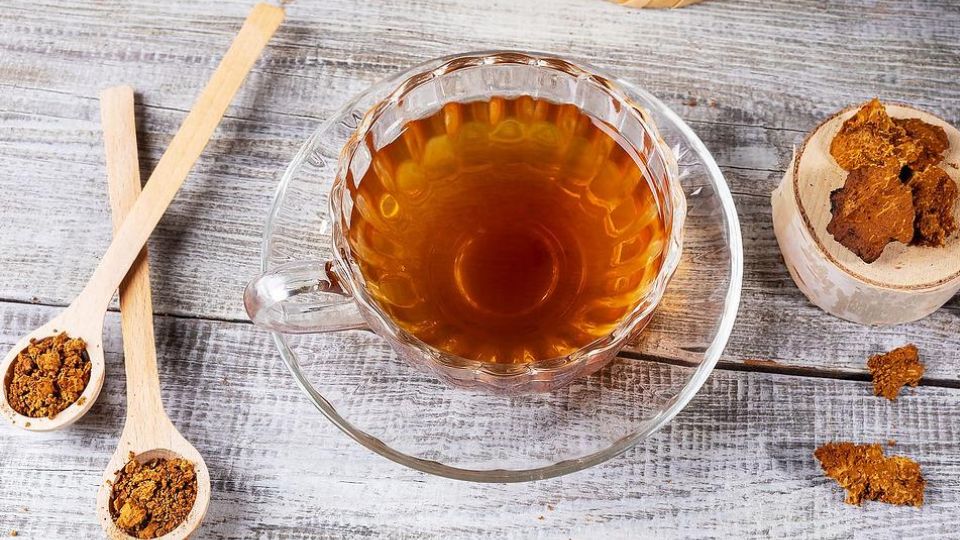
Making Chaga tea is a delightful and rewarding process. To prepare the mushroom tea, you have two options. First, use roughly 10 grams of whole mushroom chunks. Alternatively, grind the chunks into powder using a coffee grinder, and take about two teaspoons of the mushroom powder. Whichever method you choose, rest assured it’s a simple beverage you can easily make at home.
Here is the step-by-step on how to make it:
- Gather Your Chaga: Start by sourcing high-quality Chaga mushrooms, either in the form of raw chunks, powder, or an extract from a reputable supplier.
- Prepare the mushroom: If you have raw Chaga chunks, break them into smaller pieces using a mortar and pestle or a grinder. For the mushroom extract, follow the manufacturer’s instructions for dosage.
- Boil Water: Bring clean, filtered water to a boil in a pot or kettle.
- Add the mushrooms: Once the water reaches a rolling boil, add the Chaga chunks or the mushroom powder, or extract to the pot.
- Simmer: Reduce the heat to low and allow the mushrooms to simmer for at least 5 minutes.
- Strain and Enjoy: After simmering, strain the liquid to remove any remaining mushroom pieces, and your Chaga tea is ready to be savored! Feel free to sweeten with honey or add a splash of your favorite plant-based milk for added creaminess.
Potential Risks and Side Effects
While Chaga may offer an array of health benefits, it’s essential to be aware of potential risks. This mushroom contains a significant amount of oxalates, which have the potential to bind to calcium during digestion[12]. This may be a concern for those who have a history of kidney stones or kidney-related issues. If you have such conditions, it’s best to consult a healthcare professional before adding Chaga into your routine.
Who Should Avoid Taking Chaga Mushrooms?
- People on insulin or with diabetes, may impact blood sugar levels and pose risks.
- Those on blood-thinning medications, with bleeding disorders, or preparing for surgery, contain a blood clotting-inhibiting protein.
- People with autoimmune diseases can increase immune system activity and may require medical advice before use.
- Women who are pregnant or breastfeeding, as there is no research on its safety for them.
- Anyone seeking Chaga supplements should remember to buy from reputable sources since it is not monitored by the FDA.
What Precautions Should Be Taken When Using Chaga Mushrooms?
- Document any side effects from Chaga use and seek medical attention if experiencing trouble breathing, changes in heart rate, or loss of consciousness, as these may indicate an allergic reaction.
- Continue taking all prescribed medications, as are not a substitute for traditional medication.
- Avoid combining Chaga with other herbal supplements unless advised otherwise by a doctor.
- Inform your doctor about all medications you are taking, as may affect the effectiveness of certain drugs.
SUMMARY
Chaga’s safety and proper dosage remain unexplored through studies. If you have a bleeding disorder, autoimmune disease, take blood thinners, or are pregnant/breastfeeding, be cautious as unwanted side effects may arise. For your well-being, it’s essential to seek professional advice before considering chaga.
Conclusion
Chaga mushroom, with its fascinating properties and potential health benefits, has earned its place as a coveted superfood in the mycological world. From cancer-fighting properties to immune system support, Chaga has captured the attention of health enthusiasts worldwide.
To date, researchers have primarily conducted studies on this mushroom using animal subjects or human cells. Hopefully, research with human subjects will become more common to demonstrate the mushroom’s health benefits.
Incorporating a moderate amount of these mushrooms into your diet is easy with mushroom coffee or mushroom tea. Despite sounding unusual, drinkers actually say mushroom coffee tastes great and provides them with more balanced energy.
If you want to try Chaga mushroom tea or supplements but have concerns about side effects or potential interactions with your medications, it’s essential to talk to your doctor first.
Discover the incredible benefits of Chaga mushrooms with our comprehensive guide.
Discover the incredible benefits and uses of Chaga mushrooms with our user-friendly resources. Learn how to easily integrate them into your daily routine for enhanced health and well-being.
- What Does Chaga Tea Taste LikeWhat Does Chaga Tea Taste Like? Good or Bad? Do you ever wonder what Chaga mushroom tea tastes like? You’re not alone! In the West, … Read more
- Best Chaga Mushroom SupplementThe Best Chaga Mushroom Supplement: Our Top 6 Picks for 2025 *Last updated on Jan 13, 2025* If you’re looking for the best chaga mushroom … Read more
- The Two Sides of ChagaWhat Are The Two Sides of Chaga? Truth Revealed Chaga, a medicinal mushroom with a long history of use by local populations, has gained immense … Read more
- Does Chaga Have CaffeineDoes Chaga Tea Have Caffeine? All You Need to Know Does Chaga contain caffeine? Chaga has a historical role as a coffee substitute, though it … Read more
- Chaga Tea RecipeBoost Your Health with Homemade Chaga Tea Recipes Enhance your immunity and promote overall well-being by incorporating the powerful chaga tea into your routine. Learn … Read more
- Chaga Mushroom IdentificationChaga Mushroom Identification: The Ultimate Guide For Foragers Chaga mushroom is a highly regarded wild, edible fungi known for its potent superfood qualities. It differs … Read more
- Chaga Benefits for SkinTop 6 Chaga Benefits for Skin: All You Need to Know For centuries, Chaga mushrooms have played a significant role in traditional medicine, and recent … Read more
- How to Make Chaga TeaHow to Make Chaga Tea at Home with Easy Recipes! Chaga tea, derived from the chaga mushroom, offers potential health benefits and is simple to … Read more
- Chaga CoffeeChaga Coffee – Is It Worth to Buy? Chaga coffee is gaining popularity among health-conscious coffee lovers. It involves combining chaga mushroom powder with coffee … Read more
Reference
1. Ultraviolet radiation promotes the production of hispidin polyphenols by medicinal mushroom Inonotus obliquus. Retrieved from https://www.researchgate.net/publication/364401858_Ultraviolet_radiation_promotes_the_production_of_hispidin_polyphenols_by_medicinal_mushroom_Inonotus_obliquus
2. Phytochemistry, traditional uses and health benefits of the mushroom inonotus obliquus (Chaga). Retrieved from https://www.researchgate.net/publication/292243402_Phytochemistry_traditional_uses_and_health_benefits_of_the_mushroom_inonotus_obliquus_Chaga
3. Mycosynthesis: Antibacterial, antioxidant and antiproliferative activities of silver nanoparticles synthesized from Inonotus obliquus (Chaga mushroom) extract. Retrieved from https://www.sciencedirect.com/science/article/abs/pii/S1011134413002741
4. Biological and anticancer properties of Inonotus obliquus extracts. Retrieved from https://www.sciencedirect.com/science/article/abs/pii/S1359511318304537
5. Inonotus obliquus Aqueous Extract Suppresses Carbon Tetrachloride-induced Hepatic Injury through Modulation of Antioxidant Enzyme System and Anti-inflammatory Mechanism. Retrieved from https://www.researchgate.net/publication/356667290_Inonotus_obliquus_aqueous_extract_suppresses_carbon_tetrachloride_induced_hepatic_injury_through_modulation_of_antioxidant_enzyme_system_and_anti-inflammatory_mechanism
6. Antitumor activity of water extract of a mushroom, Inonotus obliquus, against HT-29 human colon cancer cells. Retrieved from https://onlinelibrary.wiley.com/doi/10.1002/ptr.2836
7. Effects of Korean Chaga mushroom extract on stimulation of immune response in mouse splenocytes. Retrieved from https://faseb.onlinelibrary.wiley.com/doi/10.1096/fasebj.23.1_supplement.571.8
8. Anti-diabetic effects of Inonotus obliquus polysaccharides-chromium (III) complex in type 2 diabetic mice and its sub-acute toxicity evaluation in normal mice. Retrieved from https://pubmed.ncbi.nlm.nih.gov/28087233/
9. Methanol extract of Inonotus obliquus improves type 2 diabetes mellitus through modifying intestinal flora. Retrieved from https://www.researchgate.net/publication/366922038_Methanol_extract_of_Inonotus_obliquus_improves_type_2_diabetes_mellitus_through_modifying_intestinal_flora
10. Anti-inflammatory effect of Inonotus obliquus, Polygala senega L., and Viburnum trilobum in a cell screening assay. Retrieved from https://www.sciencedirect.com/science/article/abs/pii/S0378874109004036
11. Antiviral activity of aqueous extracts of the birch fungus Inonotus obliquus on the human immunodeficiency virus. Retireved from https://pubmed.ncbi.nlm.nih.gov/26182655/
12. Chaga mushroom-induced oxalate nephropathy. Retrieved from https://pubmed.ncbi.nlm.nih.gov/23149251/
